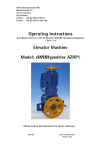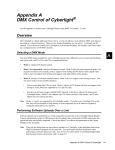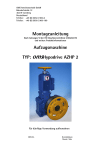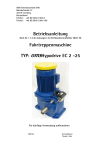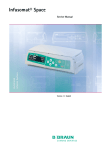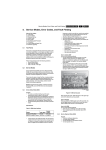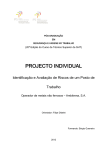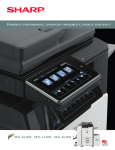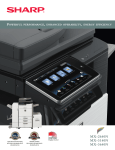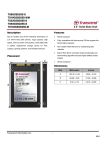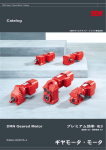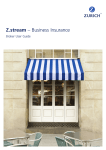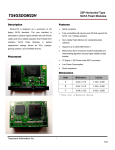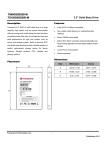Download Operating Instructions Elevator Machine Model
Transcript
OMS Antriebstechnik OHG Bahnhofstraße 12 36219 Cornberg Deutschland Telefon: +49 (0) 5650 / 969-0 Telefax: +49 (0) 5650 / 969-100 Operating Instructions According to Annex I of the EC Directive 98/37/EC Mechanical Equipment – Part 1.7.4 Elevator Machine Model: omsHypodrive AZHP 3 Please archive this document for future reference OMS No. Date of Manufacture Month / Year Operating Instructions AZHP 3 (Technical changes reserved – Last Changes 09/2005) List of Contents Page 1 INTRODUCTION 4 2 SAFETY INSTRUCTIONS FOR OMS ELEVATOR MACHINES 5 Applicable Use None Applicable Use Warranty and Liability for the Elevator Drive Dangers, that are associated with the Elevator Drive Instructions for Safe Use Requirements and Qualification - Installation and Maintenance Personnel General Information 5 6 8 8 9 2.1 2.2 2.3 2.4 2.5 2.6 2.7 3 3.1 3.2 3.3 3.4 3.5 3.6 4 4.1 4.2 5 5.1 5.2 5.3 5.4 5.5 6 6.1 6.2 6.3 6.4 6.5 6.6 6.7 6.8 CONSTRUCTION AND FUNCTION Technical Data Noise Emission Information Manufacturers Identification Plate Modules and Additional Parts – Spare Parts Alternative Configurations Gearbox Variations and Applicable Mounting Configurations TRANSPORT AND STORAGE Transport Storage PREPARING FOR USE Assembly The Brake Emergency Release – Installation and Operation Adjusting the Brake Function Control Installing the Rope Clamp 9 9 10 11 11 11 12 12 12 15 15 15 17 17 20 23 24 25 REGULAR USE AND MAINTENANCE 26 Recommended Routine Maintenance Error – Troubleshooting Errors Gearbox Oil Replacing the Traction Sheave Brake Maintenance Replacing the Incremental Encoder Replacing the Motor Replacing the Elastic Clutch Gasket 26 27 27 29 30 33 33 34 Page 2 of 52 Operating Instructions AZHP 3 (Technical changes reserved – Last Changes 09/2005) 7 7.1 7.2 8 A B C D E F DISASSEMBLY Disassembly of the Elevator Drive Scrapping the Elevator Drive ADDENDUM Technical Data OMS – Elevator Machine AZHP 3 Dimensions OMS - Elevator Machine AZHP 3 Electrical Connections Traction Sheave Technical Releases, Declaration of Conformity EC-Safety Data Sheet SYNTHESO D/EP-Oils 35 35 35 36 37 38 41 45 47 49 Page 3 of 52 Operating Instructions AZHP 3 (Technical changes reserved – Last Changes 09/2005) 1 Introduction These instructions include pictograms for commenting on Warnings and Safety Issues. Application Tip: Additional Comments and Information, no danger involved Warning: of a general risk for the machine or a human safety hazard Warning: of dangerous currents, a liability of serious damage to health or death Warning: of hot surfaces, a liability of serious damage to health and / or serious material damage Warning: of crush injuries, a liability of serious damage to health Warning: of drawing in, a liability of serious damage to health Warning: DANGER Risk for the machine or a human safety hazard, a liability of serious damage to health or death Page 4 of 52 Operating Instructions AZHP 3 (Technical changes reserved – Last Changes 09/2005) 2 Safety Instructions for OMS Elevator Machines 2.1 Applicable Use The OMS-Elevator Machine AZHP 3 is for operating electrically driven sheave drive elevators for passengers or goods according to EN 81-1. The installation and use of the AZHP 3 for other purposes is not applicable. The OMS ANTRIEBSTECHNIK OHG are not liable for personal injury and or damage resulting from none applicable applications. All Planning, installations and maintenance work may only be carried out by qualified personnel. Qualified personnel are such who having studied for qualifications, or are experienced, or have received instruction and have the knowledge relating to the relevant standards and directives, safety regulations and local knowledge required to install and maintain the machine and be able to recognise and access the risks appertaining to this machine. (Qualified Personnel, as defined in IEC 364). This OMS – Elevator Drive is applicable to the 9th Directive of the Machine and Product Safety Law (9. Verordnung zum Geräte- und Produktsicherheitsgesetz (Maschinenverordnung) and the 98/37EC Machine Directive. It is part of a plant that it is to implemented in an elevator system and is therefore not liable for CE certification. The required manufacturers release is included within these instructions (Page 48). The commencement of regular use is not permitted until the erection (according to Elevator Directive 98/16 EC) has been completed in the pre determined elevator system and the CE label has been applied to the elevator to show that the safety requirements have been fulfilled for the machine as supplied by the manufacturer. All other required regulations and certificates (e.g. applicable to general use, maintenance and inspections) remain in force. The drive manufacturer only respects the warranty for operation and safety of the drive if it is has been erected, maintained and operated according to the printed specifications supplied individually with each drive. The warranty is void if the parameters outlined in the operating, maintenance and control documentation have been exceeded. An incorrect installation or incorrect use of the system, and or violation of the standards outlined above, lead to a complete and absolute none liability of the drive manufacturer. The motors should only be used in conjunction with frequency converters. Customer supplied frequency converters must be set up according to their instruction sheets, in order to comply with the requirements of the OMS-Elevator Machine. Page 5 of 52 Operating Instructions AZHP 3 (Technical changes reserved – Last Changes 09/2005) The OMS-Elevator Machine AZHP 3 is for operating elevators and has been designed for installation in an enclosed area (e.g. elevator shaft or machine room). OMS Drives may only be stored, erected and run in dry closed areas. The IQ/OQ representative and the user must ensure that adequate measures are taken to avoid a contamination with building dust and or dirt. The machine may only be stopped by the frequency converters and with the machine brake. OMS-Elevator machines may only be operated when in technically good condition and within the parameters as described by OMS. Applicable use also includes the following: • Working according to the supplied instructions, • Observing the regulatory safety and environmental requirements, • Adherence and observance of the Elevator documentation and regulations. 2.2 None Applicable Use OMS Drives may not be operated in potentially explosive or environmentally aggressive areas. The double circuit safety brake is only designed for a limited number of emergency stops. It’s use as a stand operation brake is not permissible. Further operation is not permissible once the pre determined wear points have been achieved. Permissible Limits: • • • • • max. Motor Speed: refer to technical documentation; max. Drive Wheel Load: refer to technical documentation; max. Number of Starts / Hour = 240; Local ambient temperature during operating min.: 5° C, max.: 40° C; The technical data and specifications on the Motor Data Label are only valid for an installation height up to h ≤ 1000m over NN. • Max. rel. Humidity: 85% at 20°C (none condensing) None applicable use also includes the following: - Dry operation without oil or use of a lubricant other than specified - Securing the drive with bolts weaker than those specified - Opening the Gearbox when installed on the drive Page 6 of 52 Operating Instructions AZHP 3 (Technical changes reserved – Last Changes 09/2005) Important: • All work related to; Transport, Electrical Connections, pre-Service Checks and Maintenance of the Drive System must be carried out by qualified technicians. Incompetent work can lead to serious personal injury and / or damage. Warning ! Special Notes appertaining to AZHP 3: • The machine is very efficient and has a very low natural friction rate. The machine operates immediately after the brake has been released. • During the installation of the Safety gear , it is important that the Machine Brake is available and that the brake can be operated at any time as and when required. • Using the elevator when the Emergency Brake is not operable is forbidden. The operator is responsible for the welfare and safe running of the elevator and all persons within. • Regular checks of the Safety gear and the Buffer must be carried out according to EN 81-1 Appendix E with an empty cabin and at reduced speed. Regular checks should not cause wear or stress which could lead to a lessening of elevator safety. Due to the inherent high level of efficiency, the drive should not be tested at speeds higher than vmax. ≤ 1,0ms-1. Otherwise serious damage could be caused to the drive and/or other parts of the elevator system. Alternatively, the checks can be performed using test weights and testing at nominal speed. • The cabin may only be pulled out of the Safety gear by moving the cabin in the opposite direction that caused the Safety gear to holt the elevator. The elevator Machine may only be operated in a situations with the maximum loads as given by the machine specification. All other methods, which would put additional static or dynamic loads on the for example the Traction sheave , Motor or Gearbox are forbidden. OMS will not respect any warranty claims resulting from practices other than those laid out in this document. • Ensure that the motor does not rest on or against the frame. If this should be the case, take appropriate action to remedy to free the motor. Take care to inspect the motor and the frame on each installation and document your actions. Page 7 of 52 Operating Instructions AZHP 3 (Technical changes reserved – Last Changes 09/2005) 2.3 2.4 Warranty and Liability for the Elevator Drive • The drive manufacturer only respects the warranty for operation and safety of the drive if it is has been erected, maintained and operated according to the printed specifications supplied individually with each drive. • The warranty is void if the parameters outlined in the operating, maintenance and control documentation have been exceeded. • The customer is responsible for the qualified installation of the drive by certified personal. • If damage or other problems are found on the elevator or the drive, then the system must be disabled, otherwise the operator will be liable for all damage and injury appertaining thereto. • An incorrect installation or incorrect use of the system, particularly with respect to the forbidden procedures outlined above, lead to a complete and absolute none liability of the drive manufacturer. • This is also applicable, when after damage has occurred, the operator and/or the installer and /or the maintenance company cannot supply a fully documented list of procedures relating to the erection, testing, maintenance and SOP’s of the elevator (Elevator Book etc). Dangers, that are associated with the Elevator Drive Our elevator drives are at the cutting edge of technology and are delivered in a safe operating configuration. Any changes made by that customer or his operative that may affect the inherent safety of the elevator drive are not permissible. The Drive Sheave and the Hand Wheel of the AZHP 3 are delivered by OMS without a safety cover and may only be operated in a secure Machine Room. Take care when working the Machine Room that an adequate safety distance is maintained away from the moving parts (yellow). The elevator supplier is responsible for installing safety shields if required. Page 8 of 52 Operating Instructions AZHP 3 (Technical changes reserved – Last Changes 09/2005) 2.5 Instructions for Safe Use If changes are observed during the service lift of the machine, e.g. wear, ageing etc. then the machine should be serviced and the changes dealt with, according to the OMS General- and Maintenance Instructions. The gearbox may only be opened by OMS at our factory site; the warranty will otherwise become invalid. 2.6 Requirements and Qualification - Installation and Maintenance Personnel All installations, maintenance work and repairs on the electrical parts of the machine may only be carried out by qualified personnel. Qualified personnel are such who having studied for qualifications, or are experienced, or have received instruction and have the knowledge relating to the relevant standards and directives, safety regulations and local knowledge required to install and maintain the machine and to be able to recognise and assess the risks appertaining this machine. (Qualified Personnel, as defined in IEC 364). OMS recommend that the technical personnel acquaint themselves with the machine before it is erected and taken into service. Please read the General- and Maintenance Instructions carefully, these instructions will aid you to find mistakes and technical deficiencies during the installation and operating life of the machine. 2.7 General Information Should damage occur during transport, or should the machine appear during erection to have errors or be damaged, please contact OMS and inform us of the damage or error. In case of damage caused by water, please contact OMS. A decision as to whether the damage or error can be rectified on site or not, can first be taken after the customer has contacted OMS. OMS will then decide if the machine can be taken into service or whether the machine should be returned with the original packaging – to OMS. Please retain the original packaging until after the machine has been taken into service. OMS will not accept responsibility for the correct installation and function of the elevator in the shaft. The responsibility for the correct installation and function of the elevator in the shaft lies with the elevator supplier and / or the elevator operator. Page 9 of 52 Operating Instructions AZHP 3 (Technical changes reserved – Last Changes 09/2005) 3 Construction And Function Due to the high efficiency ratio of approx. 96% the machine generates little excess heat, this ensures that the modules and aggregate parts and electronics are not exposed to excessive temperatures and therefore a detrimental effect – ageing and wear – on these parts due to temperature influence is kept to a minimum. This also means that the oil in the gearbox can be regarded as a Life-timeLubrication. In an ambient temperature of approx. 35°C and a continuous operation mode the gearbox oil can be used for 40,000 machine hours. Apart from the routine checks, the viscosity of the gearbox oil should be checked every 2 – 3 years (Ref. Chapter 6). Incremental Encoder: Between the Hand Wheel and the Motor Disc Brake: Between the Motor and the Gearbox Motor Positions: Standing or laid left or right Traction Sheave: Drive Flange on the Gearbox Safeguard Device: Against Rope Jumping: Double, Adjustable Gearbox Casing: With Base Plates and Flanges Fig. 1: OMS-Elevator Machine AZHP 3, General Layout Page 10 of 52 Operating Instructions AZHP 3 (Technical changes reserved – Last Changes 09/2005) 3.1 Technical Data The efficiency of the OMS-Elevator Machine, relationship to the Elevator Cabin (1:1 or 2:1), Gearbox Version Specification, and possible installation constellations can be found in the Appendix: „Technical Data OMS – Elevator Machine AZHP 3“ All measurements and fitting details for the OMS Elevator Machine can be found in the Appendix: “Dimensions Sheet – Elevator Machine AZHP 3“ 3.2 Noise Emission Information All OMS elevator machines are subjected to a thorough noise emissions test before leaving our factory site. The test is conducted according to DIN EN ISO 11200 at a mean distance of 1 meter to the machine surface. Test procedure: The machines are driven through Frequency Converters, the actual level of effort reflects the known torque load and the drive speed. When working to the given limits, the machines emit the following noise emission parameters. Machine AZHP 3 - LD AZHP 3 - HD AZHP 3 – HD+ Max. Sound Pressure Level LpA in dB(A) < 61,0 at < 1500 min–1 < 62,0 at < 1500 min–1 < 62,0 at < 1500 min–1 If you have any further questions regarding noise emissions, please contact OMS. 3.3 Manufacturers Identification Plate The following information can found on the manufacturers identification plate. For Example: OMS ANTRIEBSTECHIK OHG 36219 CORNBERG GERMANY AZHP 3-37HD+-11T-K605-02-B3 OMS Nr. - Baujahr xxxx-mmyy OMS-Auftrag: xxxxxx Kommission: xxxxxxxxx Übersetzung: 36,85/1 Model: AZHP 3 Ratio: 37 Set Up Configuration: HD+ Motor Model: 11 Encoder: T Traction Sheave: K605 Brake Model: 02 Mounting Configuration: B3 OMS-No. - xxxx-Month Year MMYY Page 11 of 52 Operating Instructions AZHP 3 (Technical changes reserved – Last Changes 09/2005) 3.4 Modules and Additional Parts – Spare Parts The OMS-Elevator Machine AZHP 3 consists of: • • • • • Gearbox complete Motor, complete with Incremental Encoder (between Hand wheel and Motor Cover) Brake system, complete (including Brake Drum and Clutch) Traction Sheave Safeguard device against Rope jumping (2-x) Optional: • Rope Clamp • Lever System (2-x, each for opening one Brake Circuit manually) • Traction Sheave Brake, a safety item for controlling the speed of an ascending cabin as specified in EN 81 3.5 Alternative Configurations The elevator machines can be supplied with the following alternative configurations: • • • • • • Gearbox: Ratio i = 18,99 (Suspension. 2:1), i = 36,85 (Suspension 1:1), i = 13,57 (Suspension 2:1) and i=24,68 Suspension (Suspension 1:1 and 2:1). Electric motors: various sizes Incremental Encoder with various signal outputs: SINE, HTL, TTL Brake solenoids and Brake Springs: various strengths and electrical controls Traction Sheave: various diameters (320, 450, 500, 560, 650 mm, others optional) Safeguard device against rope jumping: Various fitting lengths, corresponding to the traction sheaves, are available 3.6 Gearbox Variations and Applicable Mounting Configurations The design of the OMS-Elevator Machine AZHP 3 enables an erection in various constellations: The following diagrams show the Output Shaft and the dotted outline of the Traction sheave. In the standard Gearbox version the Output Shaft is located to the left of the long axis of the Motor (Version A). The Drive Shaft can be optionally positioned to the right of the long axis of the Motor (Version B). According to the configuration , the Oil Dipstick or Air Bleeder Valve will be found on the highest position on the Gearbox Casing (See the notes on the diagram). Page 12 of 52 Operating Instructions AZHP 3 (Technical changes reserved – Last Changes 09/2005) Oil Dipstick Oil Dipstick Fig. 2 Standard (Version A1), Motor vertical Oil Dipstick Fig. 4 (Version A3), Motor Horizontal (low) Oil Dipstick Fig. 6 (Version A2), Motor Horizontal (high) Fig. 3 Standard (Version B1), Motor vertical Oil Dipstick Fig. 5 (Version B3), Motor Horizontal (low) Oil Dipstick Fig. 7 (Version B2), Motor Horizontal (high) Page 13 of 52 Operating Instructions AZHP 3 (Technical changes reserved – Last Changes 09/2005) Comments: The standard position of the Terminal Connector Box on the Motor frame is in the direction of the Brake solenoid, but can be rotated with the Motor by 90° or 180°. To rotate the connector box, the motor fixing bolts must be unscrewed. Beforehand, disconnect the electrical supply and secure the machine against an unintentional power input. After repositioning the motor with the connector box, the bolts must be diagonally re-tightened (50Nm). If the force acting on the cable has a torque component which is perpendicular to the direction of the Gearbox fixing bolts, then an additional bracket must be used that supports the drive unit in this perpendicular direction, thus preventing the fixing bolts from being adversely affected by the sheer strength forces due to the elevator load. (If you have any questions on this issue, please contact OMS). Fixing Bolts Bracket 20 mm Force Fig. 8: Additional Bracket Fig. 9: Additional Distancing Plate In the position: „Motor Horizontal Low“, a larger motor (160) can be implemented for dealing with higher capacities. The lower outer edge of the motor will then intrude over the standing area occupied by the gearbox. Should there be a piece of the chassis frame available at this point, then a distancing plate of at least 20 mm must be placed under the gearbox standing area. To ensure adequate lubrication and Gearbox efficiency, the elevator machine may only be erected as ordered. Page 14 of 52 Operating Instructions AZHP 3 (Technical changes reserved – Last Changes 09/2005) 4 Transport and Storage 4.1 Transport All elevator machines are inspected and passed prior to leaving our factory site. When you accept delivery of your machine, please check the packaging for signs of exterior damage. If you find damage which appears to have been caused in transit, then please document this damage in the presence of the delivery agent. The machine may not be taken into service. The Machine leaves the OMS factory in an Oil tight state. If the Machine has to be transported after having been installed, then the oil Dipstick and/or Air Bleeder Valve must be removed and replaced with the original OMS Oil Sealing Plugs. If the plugs are not available, please order new sealing plugs from OMS. The weight of the machine (without traction sheave) can be found in the table on page 37. The weights of the traction sheaves can also be found on this page. 4.2 Storage The Elevator Machine must not be stored outside and may not be exposed to outdoor weather conditions. If it is planned to store the machine for a longer period of time before installing it, then the measure must be undertaken to ensure an adequate conservation of the machine. A) Up to 3 Months Storage: No special storage requirements. Before the Elevator Machine is installed the following points should be observed: • All the Brake Parts must be inspected (activate the Brake in case there should be light corrosive spots on the Brake Drum). • Turn the Machine a few times by hand, (to ensure that the Motor Bearings are evenly greased). B) Up to 18 Months Storage: If it is planned to store the machine for a longer period of time before installing it, then the Machine can be ordered with the optional conservation kit. The Machine is then treated in the OMS factory and packed in a humidity proof yellow plastic foil. If this wasn’t the case, then: • • At the latest, after six months Storage the Gearbox must be filled to the highest bolt hole with Oil. Warning: Oil Type: See the yellow label; only use one sort of Oil. Page 15 of 52 Operating Instructions AZHP 3 (Technical changes reserved – Last Changes 09/2005) • After filling with Oil, the Machine must be packed in a humidity proof (yellow) foil: (this foil can be ordered from OMS) • Dry Storage is required. Before the Machine is installed: • Reduce the Oil Level! to the standard level (ref. Chapter 6.1.1) • All the Brake Parts must be inspected (activate the Brake in case there should be light corrosive spots on the Brake Drum). • Turn the Machine a few times by hand, (to ensure that the Motor Bearings are evenly greased). • Install the Machine (Ref. Chapter 5. Preparing for use) C) Longer than 18 Months Storage: Optional factory conservation or procedures as in: B) Up to 18 Months Storage Dry Storage is required. Before the Machine is installed: • Change all the Gearbox Oil. Take care to use the correct type of Oil and observe the Oil Level as outlined under: 6.1.1 and 6.1.3. • All the Brake Parts must be inspected (activate the Brake in case there should be light corrosive spots on the Brake Drum) • Turn the Machine a few times by hand, (to ensure that the Motor Bearings are evenly greased). • If the Machine cannot be turned by hand, or the movement is stiff, then the Motor Bearings may have to be replaced. • Install the Machine (Ref. Chapter 5. Preparing for use) After a lenghty storage period, the manufactures warranty will have run out. If a further warranty period is required, then the Machine may be returned to OMS to be refurbished (new Bearings etc.), this will incur some expense for the customer. Damage, that has been caused by negligible handling is not covered by our warranty specification. Page 16 of 52 Operating Instructions AZHP 3 (Technical changes reserved – Last Changes 09/2005) 5 Preparing For Use 5.1 Assembly It is important that the planned frame or foundation for the elevator machine(s) has been calculated with an adequate reserve. The frame must be stiff enough to resist the tension- and torque stresses that will occur during normal operation. 5.1.1 Elevator Machine, complete Fasten the Machine in the required position via the four mounting holes in the Gearbox Supports. Recommended is a through and through fastening with complete bolts each with a securing nut. Bolts: M 20 in Quality 10.9 Torque: 350 Nm If required, supporting brackets and distancing plates should be used. (see examples, Figs 8 and 9). Pre Use Requirements: Exchange the labelled sealing plug on the Gearbox Casing with the supplied Oil Dipstick or the supplied Air Bleeder Valve. Take care to observe the correct positioning of the Gearbox (See Figs. 2-7). Retain the sealing plug for possible future transportation of the Machine. Important: The Gearbox has been sealed against oil leakage during transport. The Gearbox is airtight due to the sealing plug(s). If the Gearbox were to be taken into use with the sealing plug(s) in place, then excess pressure may build up in the Gearbox, eventually causing the Gearbox to leak – oil will be pressed out through the Shaft Gaskets. The Oil Dipstick does not seal the Gearbox. Electrical Connections Only qualified personnel may open the Terminal Box on the Motor and connect the machine to the electrical supply. Only qualified personnel may carry out repairs and service work on the electrical parts of the machine. Disconnect the main switch beforehand and secure the switch against unintended operation! “The Safety Rules for the Construction and Erection of Elevators“ according to DIN – EN 81-1 must be observed at all times. Page 17 of 52 Operating Instructions AZHP 3 (Technical changes reserved – Last Changes 09/2005) Important: The electrical system for the machine has been designed according to: EN 60 204 – 1. In order to ensure failure free function of the machine, it is recommended that all wiring should be shielded according to the standard EMV regulations. Avoid ground loops when connections include multiple shields. Procedure: 1. Motor: The electrical connections should be connected as per the diagram in the Motor Terminal Box. (See also: Appendix, Electrical Connections). Should a different wiring exit position be required, the Terminal Box can be turned by loosening the internal fixing screw and repositioning the Terminal Box. Please take care when adjusting the fine wiring of the temperature monitor switches. 2. Frequency Converter: The connection and setting up of the Converter together with the OMS-Elevator Machine must be carried out according to the instructions supplied with the Converter. 3. Incremental Encoder: The Incremental Encoder (between Motor Cover and Hand wheel) is supplied with a 5m-shieded cable and a 2 row 15-pin connector, which should be connected to the Frequency Inverter. The shielding is wired to the plug casing, PIN 12 and the Incremental Encoder. According to the Incremental Encoder used, the wiring for the connector can vary (See Appendix, Electrical Connections, Incremental Encoder). Should the Connector on the Frequency Inverter be non-compatible, adapters and longer cables are optionally available (See Appendix). 4. Brake Solenoid: The connection of the Brake Solenoid (Two Circuit Double Stroke Expanding Magnet), should be carried out according to the current regulations and requirements (See, Appendix, Brake Solenoid). a) if the machine is accessible in a service room, then both Brake Magnet Circuits may be connected to a single Control Module. b) in the machine is installed in an inaccessible position, and if emergency control and checking of each circuit will be done by purely electrical means, then each Magnet must be connected to two separate Control Modules, which in turn must be individually wired (for checking the individual Brake Circuits, Ref. 5.2.3b1). Page 18 of 52 Operating Instructions AZHP 3 (Technical changes reserved – Last Changes 09/2005) 5.1.2 Safeguard Device against Rope Jumping The safeguard devices must be fitted to the elevator machines. The Rope Jump Devices can be fitted after the cables have been installed. They must be adjusted so that they do not rub or bind and there must be a gap between the Ropes of between max. 1 – 2 mm. The safeguard device against rope jumping is supplied twice and consists of the following components each: • 2 Distancing Cylinders • 1 Bracket • 2 Bolts M 10x75 • 1 Safety Bolt M16 1. 2. 3. 4. 5. 6. Bracket 2 Cylinders Bolt Nut – M16 – 8 Bolt – M10 x 75– 8.8. Washer A – 10,5 Fig. 10: Assembly, Safeguard Device against Rope Jumping Fitting the Safeguard Device against Rope Jumping and determining the rope run through direction: 1. Loosen the Bolts M 10 x 75 (2 per Bracket) 2. Swing the Rope Jump Resistor into the required position. 3. Bolt the Bracket to the nearest available hole in the Gearbox casing using the bolts; M10x75. Adjustment according to the Drive Sheave diameter: 1. Loosen the M16 nut on the Safety Bolt. 2. Push the Safety Bolt along the slit to the required position. 3. Retighten the M16 nut on the Safety Bolt. Page 19 of 52 Operating Instructions AZHP 3 (Technical changes reserved – Last Changes 09/2005) 5.2 The Brake 5.2.1 Setting the Brake The required Magnet Field Strength and Spring Resistance is determined in the factory according to the rated torque of the Motor. Normally implementing a short overexcitation will open the Magnet, i.e. the Magnet is opened with a higher force. To compensate for wear of the Brake Lining and allow for a visible wear check, a gap of 1,5mm is set between the Magnet Pins and their relevant Pressure Bolts. (Control and Adjustment of this gap, Ref. 5.2.2). Before the Elevator is taken into service, the function of the Brake System must be controlled. If the Braking Torque does not suit the local requirements, you can set the Braking Torque accordingly. According to the rated torque of the Motor, the following Braking Torques have been pre set at the factory (TB =1,2 *TNenn), per Braking Circuit (= per Braking Lever) (See Table): Motor Rated Torque T *) [Nm] Up to 90 120 Brake Torque p. Brake Lever Spring Length (L) Spring Length (L) Magnet Size B *) [Nm] 108 120 Pre Set [mm] 76 73 Min [mm] 74 69 Model 031, 033 041, 043 Magnet Rated Torque AZHP 3 Model *) [N] 720 1100 Standard : HD HD ; HD Plus *) See „Technical Data OMS-AZHP 3“ 5.2.2 Adjusting the Brake Point: 1. With the Brake disengaged, loosen the frontal Nut M12 on the Brake Lever. 2. Pull the Safety Cover back. (See Fig. 11). The pre set Brake Spring Pressure can be adjusted by turning the Brake Spring Pressure Screw. (Turning clockwise increases the pre set Pressure). Page 20 of 52 Operating Instructions AZHP 3 (Technical changes reserved – Last Changes 09/2005) Pressure Screw Fig 11: Loosened Brake Spring Pressure Screw Fig. 12: Tightened Brake Spring Pressure Screw 3. Measure the pre set Spring length L between both the Contact areas. (See Fig. 13). Spring Length L 1...1,5 mm Fig. 13: Measuring the Spring length (L) Fig. 14: Magnet Clearance 4. Once the required value has been achieved, move the Safety Cover forward into position over the head of the screw. If required carefully tighten the screw further. 5. Tighten the M12 nut, then check the Magnet clearance – using the Lever – as to whether the required clearance is available. If required, the Pressure Screw can be adjusted until the required 1,5mm clearance has been achieved. 6. Check whether the Brake Magnet correctly opens, mechanically by using the Control Lever, and electrically by using the Elevator Controls. Page 21 of 52 Operating Instructions AZHP 3 (Technical changes reserved – Last Changes 09/2005) 5.2.2 Control, Both Brake Circuits: Comments: The procedure for conducting the final check of the Brakes as part of the Elevator Acceptance Test is not described in detail here. Please refer to the relevant safety regulations and requirements. a) For an accessible machine, If the machine is accessible in a Service Room or Elevator Shaft, then it is possible using a tool (heavy-duty screwdriver) to laterally open the Brake levers and simply check the operation of each Braking Lever individually. b) By Remote Control If the machine has been installed in an inaccessible position, then an electrical or mechanical Remote Control will be required. b1) Separate External electrical Remote Control: To check the single Braking Torque of each Brake Circuit, the Brake Levers can be individually switched through the Electromagnets. b2) Mechanical Remote Control: To check the Brake Levers individually two linkages can be optionally supplied. They can be fitted with corrosion proof activator cables enabling the operator to check the Brake Levers from an accessible position. Fig. 15 : Remote linkage for remotely opening the Brake Levers. Page 22 of 52 Operating Instructions AZHP 3 (Technical changes reserved – Last Changes 09/2005) 5.3 Emergency Release – Installation and Operation The required Emergency Instructions – that must be placed adjacent to the Emergency Release – are not described here. Please refer to the relevant safety regulations and requirements. a) for an accessible machine Is the machine accessible in a Service Room or Elevator Shaft, then the Brake can be opened with the standard Lever on the Brake Magnet. If required the Elevator Cabin can be moved by turning the Hand Wheel on the Motor. b) By Remote Control If the machine has been installed in an inaccessible position, then an electrical or mechanical Remote Control will be required. b1) External Electrical Remote Control: If an Emergency Power Source is available, then the Electromagnets and the Motor can be wired into the Emergency Power. b2) mechanical Remote Control: The brakes can be opened using the (optional) external Brake Lever linkages. (Ref. 5.2.3- b2). Page 23 of 52 Operating Instructions AZHP 3 (Technical changes reserved – Last Changes 09/2005) 5.4 Adjusting the Brake Function Control Switch Activator Sensor M12 x 40 PNP SCHLIESSER Fig. 16 1,3 mm The Sensor must be installed with a clearance of 1,3mm between the Sensor and the Brake Magnet Casing. The sensors must be adjusted when the Brakes are in an applied state. Inductive Brake Function Sensor Information: Calculated switch clearance: 2,0mm Standard Function – The electrical circuit is closed when the brake is open Electrical Data: Voltage: Output (max): Switch frequency (max).: Switch: Connection: 10-30 V 200mA 2000Hz Closed Cable Length 2m Connection Diagram, Output: DC Wire Colour Guide BN = brown BU = blue BK = black Page 24 of 52 Operating Instructions AZHP 3 (Technical changes reserved – Last Changes 09/2005) 5.5 Installing the Rope Clamp During repair and revision periods a (optionally available) Rope Clamp can be fitted, so avoiding Rope slippage through the Traction Sheave. The Rope Clamp must be fitted to one of the openings in the Traction Sheave. (See Fig. 17). Take care, that the lug on the Clamp Bracket snaps behind the frame that follows the opening. Thus preventing a slipping of the Rope Clamp after releasing the Locking Bolts. Both Locking Bolts should be tightened so that the inner and outer bars lie parallel to each other. The inner bar is supported by the frame thus ensuring that all the ropes equally support the resulting forces. Outer Bar Traction Sheave Window in Frame of the Traction Sheave Inner Bar Fig. 17: Rope Clamp, fitted to the side of the Traction Sheave When using a Rope Clamp ensure that: 1. It cannot collide with other parts of the machine. 2. It cannot get tangled in the vertical elevator ropes. 3. It cannot block the machine. 4. That the next following Rope Jumping Safeguard Device cannot support or obstruct the Rope Clamp. If necessary remove the Bolt from the Safeguard Device. It is not permissible to raise the cabin out of the trap by using the Rope Clamp, an additional „loose rope“ and letting the balance weight fall. Page 25 of 52 Operating Instructions AZHP 3 (Technical changes reserved – Last Changes 09/2005) 6 Regular Use and Maintenance The Safety- measures and instructions for the erection and use of elevator machines as according to: DIN EN 81: “Safety rules for the construction and installation of lifts – Particular applications for passenger and goods passengers lifts”, Part 1 “Electrically operated passenger and goods lifts”, “Technical rules for lifts” and other relevant regulations and instructions must be observed at all times. The operator is responsible for the safe installation, control and maintenance according to the applicable regulations and standards. 6.1 Recommended Routine Maintenance Item Maintenance Frequency Source Oil Level, Control Every 3 Months Ref. 6.1.1 Oil Change Ref. 5.1.2 Ref. 6.1.3 Bearing, Check (Audible) In accordance with the regular elevator maintenance schedule, at least annually. Brake, Check In accordance with the regular elevator maintenance Ref. 6.3 schedule, at least annually. In accordance with the reguTraction Sheave, Check for lar elevator maintenance wear schedule, at least annually. Electrical Wiring and Con- In accordance with the regunections, Check for wear lar elevator maintenance and loose connections schedule, at least annually. Cleaning the machine sur- When required, at least anfaces nually. Safety installations and mechanisms, Check for presence and function In accordance with the regular elevator maintenance schedule, at least annually. Page 26 of 52 Operating Instructions AZHP 3 (Technical changes reserved – Last Changes 09/2005) 6.2 Error – Troubleshooting Errors Error Possible Cause Answer Unusual, none rhythmic operating noises • Grinding / Scraping Bearings • Knocking / Jumping Gears • Regulator adjustment • Call Customer Service • Check the parameters of the Frequency Converter • Call Customer Service • Check all electrical connections Oil Leak • Seal damaged Brake does not switch • Wiring is not OK 6.3 Gearbox Oil 6.3.1 Controlling the Oil Level Check the oil level at every maintenance opportunity, the oil level is checked using the Oil Dipstick. • The Oil Level must lie between the marks. 6.3.2 Controlling the Oil Viscosity In normal situations with an average temperature of approx. 35°C the Gearbox has a „life time“ oil filling and an Oil Change will not normally be required. However, we would like you to check the viscosity of the Gearbox Oil regularly. Control: • Check the oil viscosity by letting a drop of oil fall from the Dipstick onto a piece of white paper. Compare the colour of the oil with the Oil Check Card. Page 27 of 52 Operating Instructions AZHP 3 (Technical changes reserved – Last Changes 09/2005) Fig. 18 Oil Check Card • Oil colour straw yellow to mid brown: Oil good to still usable • Oil colour mid brown to dark brown: Oil change required • Oil colour dark brown to black: Oil no longer usable 6.3.3 Oil Change Should you consider an oil change to be required, please adhere to the following instructions: 1. Place a suitable container below one of the Oil Drain Screws under the Gearbox. (The Gearbox has a capacity of 9,5ltr for versions A1 and B1, and 8ltr for versions A2, A3, B2, and B3). 2. Carefully open the Oil Drain Screw. 3. After all the oil has run out, replace the Drain Screw and tighten it. 4. Replace the oil, either through the Oil Dipstick opening or through the Air Release Valve opening. 5. Observe the filling level (see 6.1.1). 6. Only fill the Gearbox with the authorised oil: Klüber Syntheso D 220 EP Amount: according to installation version (Never mix with mineral oil !) (Please contact OMS before using oil from other manufactures) 7. Close the opening, either with the Oil Dipstick or the Air Release Valve. Page 28 of 52 Operating Instructions AZHP 3 (Technical changes reserved – Last Changes 09/2005) If oil is spilled during the oil change, then the spilled oil should be cleaned up immediately. Used Oil is Special Waste! 6.4 Replacing the Traction Sheave The Traction Sheave is, like the Elevator Ropes, prone to wear and must be changed according to the regulations governing Elevators. The Traction Sheave is attached to an Adapter Flange on the Drive Shaft. The Flange has been attached in the OMS factory with a pre defined torque, and is considered a part of the Gearbox and may not be removed by the customer How to change the Traction Sheave: 1. Disable and secure the complete elevator system. (Observe the instructions of the elevator manufacturer). 2. Loosen and remove the cable from the Traction Sheave. (Observe the instructions of the elevator manufacturer). 3. Should the Safeguard Device against cable jumping require adjustment, please consult Chapter 5.1.3. 4. Secure the Traction Sheave against falling – use a rope loop – and remove the fixing bolts M12 x 55. 5. Pull the Traction Sheave from the hub of the Drive Shaft. If necessary use two bolts M20, of at least 65mm length, place the bolts in the preformed Puller Holes. Remove the remaining Clamping Pins from the screw threads and clean the centre hub. Smooth down the uneven points that may have been formed by the Puller Bolts. 6. Place the new Traction Sheave on the centre hub. Secure the Traction Sheave against falling – use a rope loop. Ensure that the Traction Sheave has complete contact around the Flange. Rotate the Traction Sheave on the Drive Shaft until the Bolt holes are aligned. 7. Drive the 8 new (supplied) Clamping Pins, DIN EN ISO 13337 – 16 x 36, fully in to the threaded holes until they lie flush against the threaded area. Bolt the Drive Wheel to the Flange using the required Bolts. (Torque: 85 Nm) Damaged bolts should be replaced (M12 x 60 - 8.8). 8. Reinstall the Elevator ropes (Observe the instructions of the elevator manufacturer). Page 29 of 52 Operating Instructions AZHP 3 (Technical changes reserved – Last Changes 09/2005) 6.5 Brake Maintenance 6.5.1 Control: Movement of the Brake Lever Within the normal maintenance program of the elevator, the movement of the Brake Levers should be regularly controlled. Open the Brake Levers as described in 5.2.3 (Control both Brake Systems). The Brake levers must close lightly, if this is not the case, then the Bolt supporting the Brake Lever must be removed, cleaned, greased and then reinstalled (Ref. 6.3.3). 6.5.2 Control: Clearance and Brake Lining Wear Comments: The brake system on elevators is a holding brake and frictional work is generated only when activated during a safety check, when the cabin is made to drop and then braked. Therefore it is to be expected that the Brake Lining should only show minimal wear during normal use. Notwithstanding, within the regular maintenance program, the clearance between the Solenoid Plungers and the relevant Pressure Bolts in the Brake Levers should be controlled. a) Clearance: The Clearance may not be less than 1,0 mm. Should the clearance have been reduced to 1mm, then the clearance must be re-adjusted to max. 1,5 mm (Ref. 5.2.1 and Fig.14). Procedure: 1. Force the Solenoid Plungers back and measure the clearance between the Plungers and the Pressure Bolts (Fig. 14). 2. Loosen the Locking Nut, turn the Pressure Bolt and re-tighten the Locking Nut. Clearance Parameter S=1,5mm. 3. After the clearance has been adjusted, check the correct function of the Brake System by mechanically activating the Lever on the Solenoid and by electrically activating the Brake using the Elevator Controls. 4. If it is no longer possible to adjust the clearance because the Bolts are touching the Brake levers, than the Brake levers must be fitted with new Brake Linings! b) Brake Lining Wear: The level of Lining wear determines the position of the Brake Lever. As the Brake Linings become worn, the Brake levers move toward the Brake Magnets. The minimal allowed clearance is clearly marked on the Brake Levers. Control of Brake Lining Wear: The minimal allowed clearance can be read above the Pressure Bolt position. (Ref. Fig. 21). If the minimal allowed clearance has been achieved, then both Brake Levers must be exchanged against Brake Levers with new Brake Linings. Page 30 of 52 Operating Instructions AZHP 3 (Technical changes reserved – Last Changes 09/2005) 6.5.3 Adjusting the Double Brake If required OMS supply their elevator drives with a second brake magnet. They can be adjusted as described in Chapter 5.2 Fig. 19 Double Brake Fig. 20 Connections Double Brake Bolt Socket Set Screw Fig. 21 Measuring the clearance between Brake Lever and Solenoid Fig. 22 Coupling the Brake Lever Page 31 of 52 Operating Instructions AZHP 3 (Technical changes reserved – Last Changes 09/2005) 6.5.4 Replacing the Brake Lever (Ref. Fig. 22) Disable and secure the complete elevator system. (Observe the instructions of the elevator manufacturer). When removing both brake levers there is no resistance available, the cabin will move! • Always change both Brake Levers! • Always complete the change on one side before moving on to the other side. • In order to change a Brake Lever, the Compression Spring must be removed together with the Securing Washer and the Locking Bolt. • Loosen the Socket Set Screw on the Hinged Bolt by 50%. • Press the Hinged Bolt up (with a flat Screwdriver under the Bolt Head) and remove it. • Remove the Brake Lever laterally, and remove the Washers. • Replace the Brake Levers in reverse order. • Don’t forget the Washers! • Adjust the Brake, and control the brake function, as described in Chapter 5.2. Important: • Measure the clearance between the Brake Lever inside edge and the top edge of the Brake Solenoid, mark this parameter less 10mm as minimal clearance clearly on the Brake Lever. (E.g. with Hammer Stamp Numbers, Ref. Fig. 21). When using new Brake Levers with new Linings, the Brake Point should first be set on the Spring Adjuster after activating the Brake a few times! (When first installed there is no resistance, the elevator cabin could slip). 6.5.5 Control: Rocker Arm for mechanically opening the Brake (optional) If the optionally available Rocker Arms have been fitted, then the free movement of the Rocker Arms and the Activators must be checked as part of the regular maintenance program. If required the parts should be greased. The Rocker Arms should be checked for wear, if required the parts should be replaced. Page 32 of 52 Operating Instructions AZHP 3 (Technical changes reserved – Last Changes 09/2005) 6.6 Replacing the Incremental Encoder Locking Screw Radial Securing Screws Locking Plate Fig. 23: Securing the Incremental Encoder Fan Cover Fig. 24:Incremental Encoder Support • Remove the Hand wheel, including Central Locking Screw and Washer. • Loosen the two Radial Securing Screws that can be found under the Incremental Encoder (Ref. Fig. 23). • The Locking Plate is secured with a screw. • The re-assembly of the Incremental Encoder should be carried out in reverse order. 6.7 Replacing the Motor Place the new Motor adjacent to the old Motor and compare the Technical Data. Warning: The Motor can become hot during operation – take care, contact with a hot Motor can result in burn injuries! • Remove the four bolts on the Motor Base, they can be found above the Brake Levers. • Lift the Motor, using Eye Ring Bolts and a rope loop; the Eye Ring Bolts can be attached laterally to the Motor. • Warning: if the Motor should fall, then it may become damaged, the Motor may not be lifted by the Hand wheel! • Replace the elastic Clutch Gasket, and clean the Clutch Claw, e.g. with compressed air. • Carefully line up the Clutch Claw with the Counterpart on the Gearbox Drive Shaft. • Carefully retighten the Motor Bolts diagonally. (Torque 50 Nm) Page 33 of 52 Operating Instructions AZHP 3 (Technical changes reserved – Last Changes 09/2005) 6.8 Replacing the Elastic Clutch Gasket Between the Motor and the Gearbox a Claw Type Clutch with an elastic Clutch Gasket is installed. The Gasket is made from a heat and humidity resistant Polyurethane material. Should the Gasket become hard and brittle due to extreme environmental conditions, an increased backlash will become noticeable between the Drive Shaft and the activated Brake. To replace the Clutch Gasket the Motor must be removed. • Remove the four bolts on the Motor Base, they can be found above the Brake Levers. • Note the position of the Hand wheel in relation to the Motor Cover. • Lift the Motor, using Ring Bolts and a rope loop (the Ring Bolts can be attached laterally to the Motor) until the Clutch Claw can be seen. • Warning: the Motor may not be lifted by the hand wheel! • Replace the elastic Clutch Gasket, and clean the Clutch Claw, e.g. with compressed air. • Replace the Motor, taking care that the Hand wheel lines up with the Motor Cover – as previously noted – thus carefully lining up the Clutch Claw with the Counterpart on the Gearbox Drive Shaft. • Carefully retighten the Motor Bolts diagonally. (Torque 50 Nm) Elastic Clutch Gasket Fig. 25: Coupling Claw between Motor and Gearbox Page 34 of 52 Operating Instructions AZHP 3 (Technical changes reserved – Last Changes 09/2005) 7 Disassembly 7.1 Disassembly of the Elevator Drive Remove the Oil Dipstick and replace it with the supplied Sealing Plug. The Gearbox is not sealed when the Oil Dipstick is fitted. To disassemble the Elevator Drive carry through the same procedure as during the assembly – but in reverse order. 7.2 Scrapping the Elevator Drive • The Gear Wheels, Axles and Bearings can be scrapped as standard steel scrap. • The forged parts can also be scrapped as standard steel scrap. • The Motor Winding and the Brake Unit are mainly brass and bronze and must be scrapped as such. • Oil and Grease must be removed and disposed of accordingly. Page 35 of 52 Operating Instructions AZHP 3 (Technical changes reserved – Last Changes 09/2005) 8 Addendum Technical Data OMS Elevator Machine AZHP 3-1 Dimensions OMS Elevator Machine AZHP 3 Motor Positioning of Version A and B Electrical Connections Technical Releases, Conformity Declarations (Page 1 and 2) We shall be pleased to receive your questions, comments and suggestions: OMS Antriebstechnik OHG Bahnhofstraße 12 36219 Cornberg Tel.: Fax: +49 (0) 5650 – 969 – 0 +49 (0) 5650 – 969 - 100 E-Mail: [email protected] Homepage: www.oms-antrieb.de Page 36 of 52 ADDENDUM A Technical Data OMS – Elevator Machine AZHP 3 (Technical changes reserved – Last Changes 09/2005) Gearbox : Input-Revolution, max.: efficiency: typical backlash range : sound pressure level (1500 rpm / nominal load): n = 2500 min-1 η,n = > 96 % 4 to 8 (arc. minutes) LpA = 62 dB(A) Application 1:1 2:1 car suspension HD gear ratio input-torque, max. output shaft max. torque max.axle torque for car load up to for car speed up to i T T F Q v 2:1 HD HD+ HD 18,99 18,99 36,85 36,85 36,85 13,57 24,68 150 Nm 150 Nm 100 Nm 100 Nm 150 Nm 150 Nm 150 Nm 2800 Nm 3700 Nm 3700 Nm 5500 Nm 2800 Nm 37 kN 53 kN 40 kN 2000 kg 2000 kg 1050 kg 2000Nm 3700Nm 53 kN 65 kN 50 kN 53 kN 1300 kg 1600 kg 1600 kg 2500 kg 2 m/s Motor: Three phase - Induction -Motor: Model / diameter B: motor-nominal torque up to: (for frequency converter use only) 4-pols, IP 54, motor protection: PTC, integral fans, Model: 132 / B = 260; Model: 160 / B = 315 T = 118 Nm Incremental encoder: HTL, TTL, Sinus Brake: Twin Circuit Double Stroke Expanding Magnet, single or tandem operation. Drive Sheave: radius: weight: width: rope diameter: number of cables: Dimensions: D = 320, 400, 450, 500, 560, 650 mm *) G = 34, 37, 46, 52, 59, 86 kg *) C = 112 mm *), F = 235mm 125 mm (only by dia. Ø 320mm) *) D, s = 10, 11 mm *) n = 4 – 7 *) *) options upon request total height A according to motor dimensions: (weight of drive, all inclusive without traction sheave): Motor Model 132 132 132 160 160 160 160 160 160 160 Other Dimensions: HD Pnenn Tnenn nnenn kW 7,5 7,5 11 15 13 12 17 20 14,5 20,5 Nm min-1 41,4 1740 63,4 1145 60,7 1745 69,4 2070 84,7 1465 98,0 1170 92,0 1765 92,3 2070 118 1170 111 1765 f A G Hz 60 40 60 70 50 40 60 70 40 60 mm 1017 1047 1047 1092 1092 1136 1136 1136 1164 1164 kg 307 317 317 357 357 386 386 386 402 402 Please refer to the Dimensions Sheet Page 37 of 52 ADDENDUM B Technical Data OMS – Elevator Machine AZHP 3 Motor Alignment Version A Page 1 (Technical changes reserved - Last Change 09/2005) The Measurement „B“ is dependent on the Motor used. This diagram, is shown without the Traction Sheave and Rope Safety System fitted. °22 Page 38 of 52 ADDENDUM B Technical Data OMS – Elevator Machine AZHP 3 Motor Alignment Version A3 Page 3 (Technical changes reserved - Last Change 09/2005) Page 39 of 52 ADDENDUM B Technical Data OMS – Elevator Machine AZHP 3 Motor Alignment Version B Page 3 (Technical changes reserved - Last Change 09/2005) °22 Page 40 of 52 ADDENDUM C Electrical Connections OMS – Elevator Machine AZHP 3 Page 1 (Technical changes reserved - Last Change 09/2005) 1. Wiring Diagram for Asynchronous Motor Junction Box: (Shorting Bars for Star – Connection) 2. Wiring Diagram for Incremental Encoder, Extensions & Adapter 2.1 Connections, Encoder ( Sinus / TTL / HTL ) Output SUB D 15 Pol. Plug PIN - No. 1 2 3 4 5 6 7 8 Signal A+ A+5V GND B+ BN+ N- PIN - No. 9 10 11 12 13 14 15 Casing Signal Shield Shield A ±: Channel 1, B ± : Channel 2, N ±: Reference 1 8 9 15 View from the Plug side (Comment: the shielding connection to PIN 12 is only required for SIN/COS Encoder to “Dietz FU”) 2.2 Encoder Extension Cable, l = 5m SUB D 15 Pol. Socket to SUB D 15 Pol. Plug OMS Part No. 3034 0060 PIN – No. Signal PIN – No. Signal PIN - No. Signal PIN - No. Signal 1 A+ 9 1 A+ 9 2 A10 2 A10 3 11 3 11 +5V +5V 4 12 Shield 4 12 Shield GND GND 5 B+ 13 5 B+ 13 6 B14 6 B14 7 N+ 15 7 N+ 15 2.3 Connections, Adapter for KEB Frequency 8 NShield Converter, 8l = 0,25m NShield Casing Casing SUB DA ±: 15Channel Pol. Socket SUB D2, 15 Plug, 3 rows 1, B ± :to Channel N ±:Pol. Reference A ±: Channel 1, B ± : Channel 2, N ±: Reference OMS Part No. 3034 0061 Page 41 of 52 ADDENDUM C Electrical Connections OMS – Elevator Machine AZHP 3 Page 2 (Technical changes reserved - Last Change 09/2005) 2.3 Connections, Adapter for „KEB“ Frequency Converter, l = 0,25m SUB D 15 Pol. Socket to SUB D 15 Pol. Plug - 3 - rows OMS Part No. 3034 0102 PIN - No. 1 2 3 4 5 6 7 8 Signal A+ A+5V GND B+ BN+ N- PIN – No. 9 10 11 12 13 14 15 Casing Signal Shield Shield A ±: Channel 1, B ± : Channel 2, N ±: Reference PIN - No. 1 2 3 4 5 6 7 8 Signal ABA+ PIN - No. 9 10 11 12 13 14 15 Casing Signal B+ +5V GND RR+ Shield A ±: Channel 1, B ± : Channel 2, R ±: Reference 1 5 6 10 11 15 viewed from the plug side 2.4 Connections, Adapter for „Ziehl-Abegg“ Frequency Converter, l = 0,25m SUB D 15 Pol. Socket to SUB D 9 Pol. Plug OMS Part No. 3034 0102 PIN - No. PIN - No. Signal PIN - No. Signal 1 1 A+ 9 2 2 A10 3 3 11 +5V 4 4 12 Shield GND 5 5 B+ 13 6 6 B14 7 7 N+ 15 8 8 NShield Casing 9 A ±: Channel 1, B ± : Channel 2, N ±: Reference Casing Signal A+ B+ +5V GND ABGND Shield A ±: Channel 1, B ± : Channel 2, 1 5 6 9 viewed from the plug side Page 42 of 52 ADDENDUM C Electrical Connections OMS – Elevator Machine AZHP 3 Page 3 (Technical changes reserved - Last Change 09/2005) 2.5 Connections, Adapter for “Danfoss” Frequency Converter, l = 0,25m SUB D 15 Pol. Socket to Phoenix Socket, 8 Pol. OMS Part No. 3034 0126 PIN - No. 1 2 3 4 5 6 7 8 Signal A+ A+5V GND B+ BN+ N- PIN - No. 9 10 11 12 13 14 15 Casing Signal Shield Shield PIN - No. 1 2 3 4 5 6 7 8 A ±: Channel 1, B ± : Channel 2, N ±: Reference Signal +5V GND A+ AB+ BN+ NShield A ±: Channel 1, B ± : Channel 2, N ± Reference Plug: Phönix Part. No. 184021 2.6 Connections, Adapter open ended cable, l = 0,25m SUB D 15 Pol. Socket to 9 open wires OMS Part No. 3034 0127 PIN - No. 1 2 3 4 5 6 7 8 Signal A+ A+5V GND B+ BN+ N- PIN - No. 9 10 11 12 13 14 15 Casing Signal Shield Shield A ±: Channel 1, B ± : Channel 2, N ±: Reference Wire - No. 1 2 3 4 5 6 7 8 9 Signal +5V A+ AB+ BN+ NGND Shield A ±: Channel 1, B ± : Channel 2, N ± Reference Page 43 of 52 ADDENDUM C Electrical Connections OMS – Elevator Machine AZHP 3 Page 4 (Technical changes reserved - Last Change 09/2005) 5. Mains Connections, OMS Braking Solenoid Connection Voltage: 230V AC Nominal current: 2 x 0,26A (parallel) resp. 0,52A (series-connected) Connection with one control module; Both solenoid coils are connected in parallel. SP2 SP2 230 V AC SP1 SP1 Connection with two control modules; Both solenoid coils are connected independently. SP1 230 V AC SP2 Page 44 of 52 ADDENDUM D Traction Sheave for OMS – Elevator Machine AZHP 3 (Technical changes reserved - Last Change 09/2005) Two pieces Traction Sheave with a flanged connector, Material: GG 25 (ca. 230HB) Optional: Hardened Guides 50HRC. Standard Traction Sheave –Undercut Wedged Guides C t d γ 2,5 mm D β Special Traction Sheave – Undercut Semicircular Guides C t d γ 2,5 mm D β Page 45 of 52 ADDENDUM D Traction Sheave for OMS – Elevator Machine AZHP 3 (Technical changes reserved - Last Change 09/2005) Special Traction Sheave – Wedged Guides sans Undercut C t d γ 2,5 mm D Available Traction Sheaves Model Traction Sheave Guides D in mm z D K3.. 320 6-10 8 K4.. 400 5-6 8-10 K4.. 450 5-6 8-11 K5.. 500 6 8-11 K5.. 560 6 8-11 K5.. 560 6-7 8-14 K6.. 650 6 8-11 K6.. 650 6-7 8-14 K7.. 750 4-7 8-14 Special Traction Sheaves 420-950 3-8 8-14 C 125 112 112 112 112 130 112 130 90+112+130 90-140 Dimensions T β° 12-17 80-104 17 80-104 17 80-104 17 80-104 17-20 80-104 17-20 80-104 17-20 80-104 17-20 80-104 17-20 80-104 any γ° 35-45 35-45 35-45 35-45 35-45 35-45 35-45 35-45 35-45 80-104 35-45 Weight kg 34 40 46 52 59 65 86 96 - Page 46 of 52 ADDENDUM E Technical Releases for OMS – Elevator Machine AZHP 3 (Technical changes reserved - Last Change 09/2005) Page 47 of 52 ADDENDUM E Technical Releases for OMS – Elevator Machine AZHP 3 (Technical changes reserved - Last Change 09/2005) Declaration of Conformity According to the EC Machine Directive 98/37/EC, Appendix II B Description : Drive Unit for Elevators according to EN 81-1 Type of Machine : AZHP 3 Machine No. : Machine Data : According to the data recorded on the Manufacturers Plate Machine, composed of the following components: 1. Hypoid Bevel / Spur Gear; (2 stages) 2. Motor; (3 Phase AC Motor, Motor Type B5 S, Protection Class IP 54, Insulation Class F) 3. Braking Unit; (Braking Solenoid, 2 x Brake Lever w/ Brake Lining, Brake Spring, Rod) 4. Traction Sheave, Safeguard against rope jump off Applicable EC Directives: EC Machine Directive 98/37/EC EC Low Voltage Directive 73/23/EC EC Prevention of Electro- Magnetic Emissions 89/336/EC Herewith we declare that the above mentioned machine in it’s original delivery state is in accordance with EC / DIN / ISO safety and health requirements due to it’s conception, construction and implementation. This machine may only be operated in elevator systems which adhere to the applicable directives and guidelines. Manufacturers Signature Dr.-Ing. Michael Militzer / Management OMS Antriebstechnik OHG; Bahnhofstraße 12; D-36219 Cornberg Page 48 of 52 Page 1/4 Material Safety Data Sheet According to 91/155 EEC Printing date 03.02.2004 Reviewed on 03.02.2004 1 Identification of the substance/preparation and of the company/ undertaking · Product details · Trade name: SYNTHESO D 220 EP · Article number: 012056 neu · Application of the substance / the preparation Lubricating oil · Manufacturer/Supplier: KLÜBER LUBRICATION MÜNCHEN KG Geisenhausenerstrasse 7 D-81379 München Tel.: 0049 (0) 897876-0 Fax: 0049 (0) 897876-333 Notfallauskunft: 0049 (0) 897876-700 · Further information obtainable from: Material Compliance Management 2 Composition/information on ingredients · Chemical characterization · Description: polyalkylene glycol oil · Dangerous components: CAS: 36878-20-3 Bis(nonylphenyl)amine EINECS: 253-249-4 Metalorganic compound R 52/53 Xi, ≤ 2.5% N; R 36-51/53 ≤ 2.5% · Additional information: For the wording of the listed risk phrases refer to section 16. 3 Hazards identification · Hazard description: Not applicable. · Information concerning particular hazards for human and environment: The product does not have to be labelled due to the calc ulation procedure of the " General Classification guideline for preparations of the EU" in the latest valid version. · Classification system: The clas sification is acc ording t o the latest edit ions of the EU-list s, and ext ended by company and literature data. 4 First-aid measures · After inhalation: Supply fresh air; consult doctor in case of complaints. · After skin contact: Wash off with soap and plenty of water. · After eye contact: Rinse opened eye for several minutes under running water. If sy mptoms persist, consult a doctor. (Contd. on page 2) GB DR Page 2/4 Material Safety Data Sheet According to 91/155 EEC Printing date 03.02.2004 Reviewed on 03.02.2004 Trade name: SYNTHESO D 220 EP (Contd. of page 1) · After swallowing: If symptoms persist consult doctor. 5 Fire-fighting measures · Suitable extinguishing agents: Water haze Foam Fire-extinguishing powder Carbon dioxide · For safety reasons unsuitable extinguishing agents: Water with full jet · Protective equipment: Wear fully protective suit. · Additional information Cool endangered receptacles with water spray. 6 Accidental release measures · Person-related safety precautions: Particular danger of slipping on leaked/spilled product. · Measures for environmental protection: Do not allow to enter sewers/ surface or ground water. · Measures for cleaning/collecting: Absorb with liquid-binding material (sand, diatomite, acid binders, universal binders, sawdust). Dispose of the material collected according to regulations. 7 Handling and storage · Handling: · Information for safe handling: Prevent formation of aerosols. · Information about fire - and explosion protection: No special measures required. · Storage: · Requirements to be met by storerooms and receptacles: Store in cool, dry conditions in well sealed receptacles. · Information about storage in one common storage facility: Store away from oxidizing agents. Store away from foodstuffs. · Further information about storage conditions: None. 8 Exposure controls/personal protection · Additional information about design of technical facilities: No further data; see item 7. · Ingredients with limit values that require monitoring at the workplace: The product does not contain any relevant quantities of materials with critical values that have to be monitored at the workplace. · Additional information: The lists valid during the making were used as basis. · Personal protective equipment: · General protective and hygienic measures: Do not inhale gases / fumes / aerosols. Immediately remove all soiled and contaminated clothing Avoid close or long term contact with the skin. Be sure to clean skin thoroughly after work and before breaks. (Contd. on page 3) GB DR Page 3/4 Material Safety Data Sheet According to 91/155 EEC Printing date 03.02.2004 Reviewed on 03.02.2004 Trade name: SYNTHESO D 220 EP (Contd. of page 2) · Protection of hands: Preventive skin protection by use of skin-protecting agents is recommended. · Eye protection: Goggles recommended during refilling · Body protection: Protective work clothing 9 Physical and chemical properties · General Information Form: Colour: Odour: Fluid Light yellow Product specific · Change in condition Pour point < -35°C (DIN ISO 3016) · Flash point: > 200°C (DIN ISO 2592) · Danger of explosion: Product does not present an explosion hazard. · Density at 20°C: ~ 1.05 g/cm³ · Solubility in / Miscibility with water: Partly miscible. · Viscosity: Kinematic at 40°C: ~ 220 mm²/s (DIN 51562) 10 Stability and reactivity · Thermal decomposition / conditions to be avoided: No decomposition if used and stored according to specifications. · Materials to be avoided: oxidizing agents · Dangerous reactions No dangerous reactions known. · Dangerous decomposition products: none under normal use 11 Toxicological information · · · · Acute toxicity: Primary irritant effect: on the skin: > 2000 mg/kg Additional toxicological information: Prolonged skin contact may cause skin irritation and/or dermatitis. 12 Ecological information · General notes: Do not allow product to reach ground water, water course or sewage system. 13 Disposal considerations · Product: · Recommendation Can be incinerated in accordance with local and national regulations. (Contd. on page 4) GB DR Page 4/4 Material Safety Data Sheet According to 91/155 EEC Printing date 03.02.2004 Reviewed on 03.02.2004 Trade name: SYNTHESO D 220 EP (Contd. of page 3) · Waste disposal key: For t his product no waste dis posal k ey according t he European Was te Catalogue (E WC) can be determined, as only the purpose of applic at ion defined by t he us er enables an allocation. The waste c ode number has to be determined in accordanc e with t he local waste disposer. · Uncleaned packaging: · Recommendation: Empty contaminated packagings thoroughly. They may be recycled aft er thorough and proper cleaning. 14 Transport information · Land transport ADR/RID (cross-border) · ADR/RID class: · Maritime transport IMDG: · IMDG Class: · Air transport ICAO-TI and IATA-DGR: · ICAO/IATA Class: · Transport/Additional information: Not classified as dangerous according to the above specifications. 15 Regulatory information · Labelling according to EU guidelines: The produc t is not s ubjec t to clas sification acc ording to the c alc ulation met hods of t he "General Classific ation Guideline for Preparations of the EU" as iss ued in the latest valid version. · Special labelling of certain preparations: Safety data sheet available for professional user on request. 16 Other information This informat ion is bas ed on our pres ent knowledge. However, this shall not const itut e a guarantee for any specific product features and shall not establish a legally valid contractual relationship. · Relevant R-phrases 36 Irritating to eyes. 51/53 Toxic to aquatic organis ms , may cause long-term advers e effec ts in t he aquat ic environment. 52/53 Harmful t o aquat ic organisms, may c aus e long-term adverse effec ts in the aquat ic environment. · Department issuing MSDS: Material Compliance Management · Contact: Tel.: +49 (0) 897876-564 GB DR




















































